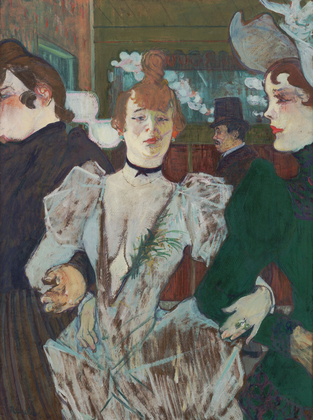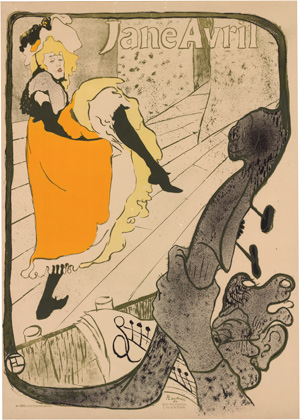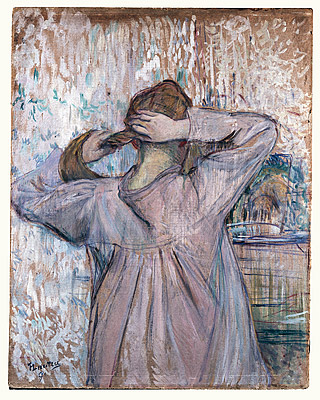exhibition review: ‘toulouse-lautrec – paris and the moulin rouge’

Henri de Toulouse-Lautrec
La Goulue entering the Moulin Rouge [La Goulue entrant au Moulin Rouge] 1892
oil on cardboard, 79.4 x 59.0 cm
The Museum of Modern Art, New York
Gift of Mrs David M. Levy
Prostitutes, drunkards and erotic dancers. These were amongst the favourite subjects of Henri de Toulouse-Lautrec (1864-1901), whose art is the subject of a major retrospective at the National Gallery of Australia, Canberra. Toulouse-Lautrec: Paris and the Moulin Rouge is composed of more than 100 works spanning his brief yet celebrated career. This includes his enigmatic portraits of women, caught up in this seedy yet electrifying atmosphere of fin-de-siècle Paris.
A social outcast himself, Toulouse-Lautrec identified with the demi-monde or underbelly of society he so evocatively captured in his paintings, prints, posters and drawings. Born into a noble French family, he suffered from congenital health disorders (caused by his patents’ intermarriage) that plagued him his whole life. When he broke his legs as a teenager they failed to heal properly, meaning that he did not grow anymore and was almost dwarf-like in statue. The exhibition highlights the artist’s early love of art, a profession he could pursue despite his poor health, and includes some of his early paintings. This interest drew him to a place that was both the epicentre of modern art and home to the fringe dwellers of French society: Montmartre, Paris.

Henri de Toulouse-Lautrec
Jane Avril at the Jardin de Paris [Jane Avril au Jardin de Paris] 1893
brush and spatter lithograph, 128.2 x 93.6 cm
National Gallery of Australia, Canberra
Gift of Orde Poynton Esq. CMG 1996
Toulouse-Lautrec: Paris and the Moulin Rouge features the artist’s evocative impressions of Montmartre: its cafes, dance halls and brothels. This includes the impressive affiches (posters) he produced to promote the area’s celebrated nightspots and performers. The exhibition showcases Lautrec’s progressive talent for lithography, which is credited as having transformed the poster into a form of art. His iconic image of celebrated Moulin Rouge dancer Jane Avril, Jane Avril at the Jardin de Paris (1893), performing the erotic can-can dance, exemplifies the expressive power of his posters. Although depicting a salacious dance, the artist’s treatment of Avril expresses his enthusiasm for her performance, not his condemnation.

Henri de Toulouse-Lautrec
The toilette (Combing her hair) [La toilette (Celle qui se peigne)] 1891
oil on cardboard, 58.0 x 46.0 cm
The Ashmolean Museum, Oxford
Bequeathed by Frank Hindley Smith 1939
Toulouse-Lautrec’s compassionate respect for women is expressed throughout the exhibition. While one could be forgiven for assuming that portraits of prostitutes could arise from a place of judgment and objectification, the reverse is true with Toulouse-Lautrec. Some of the most affecting works on display depict prostitutes with humanity. They are shown combing their hair, playing cards, engaging in household activities, and in moments of mutual tenderness. In these images the artist captures the monotony of their daily lives in a manner reminiscent of Edouard Manet’s celebrated image of a bored barmaid at another notorious Parisian nightspot, A Bar at the Folies-Bergère (1881-2). One of the most compelling of Toulouse-Lautrec’s works in the exhibition is The Toilette (Combing her hair) (1891), which depicts a prostitute from behind combing her hair. The sympathetic treatment of the figure sees Toulouse-Lautrec emphasize her femininity, rather than her profession or position within society. This reflects his intimate understanding of and appreciation for these women, gained through time spent living in brothels and befriending those who worked there.
The design of the exhibition emphasised the underbelly of society that Toulouse-Lautrec depicted in his art. The dark colours of the gallery walls evoked a sombre atmosphere: purples, blues and reds. While this colour scheme suggested the atmosphere of a nightspot, it was also somewhat oppressive. I felt this particularly at the start of the exhibition, when the deep aquamarine walls seemed to dominate the works on show. Nonetheless, the selection and layout of works was wonderful, and brought the art of Toulouse-Lautrec to life.
Nineteenth-century Parisian life remains one of the most glamorised societies of the past few centuries. Toulouse-Lautrec: Paris and the Moulin Rouge highlights an alternative and perhaps more realistic glimpse of this world. Although art, design and literature flourished in Paris at this time, so too did prostitution, alcoholism and scandalous cabaret performances. Toulouse-Lautrec’s own early and tragic demise reflects this reality: he died at the age of 36 from of complications of alcoholism and syphilis after a brief stay in a sanatorium. This is a wonderful exhibition that offers a rare insight from one who did not simply observe this world from a distance, but who lived amongst it.
‘Toulouse-Lautrec: Paris and the Moulin Rouge’ is showing exclusively at the National Gallery of Australia, Canberra until 2 April.

